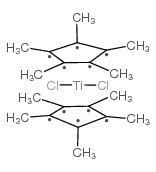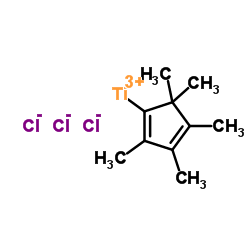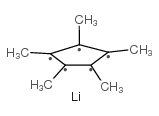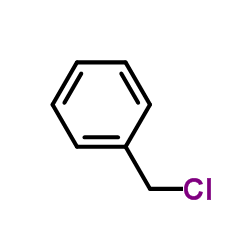39570Bis(pentamethylcyclopentadienyl)titanium dichloride

39570Bis(pentamethylcyclopentadienyl)titanium dichloride structure
|
Common Name | 39570Bis(pentamethylcyclopentadienyl)titanium dichloride | ||
|---|---|---|---|---|
| CAS Number | 11136-36-0 | Molecular Weight | 389.22500 | |
| Density | N/A | Boiling Point | N/A | |
| Molecular Formula | C20H30Cl2Ti | Melting Point | 190 °C (dec.)(lit.) | |
| MSDS | N/A | Flash Point | N/A | |
| Name | bis(pentamethylcyclopentadienyl)titanium dichloride |
|---|---|
| Synonym | More Synonyms |
| Melting Point | 190 °C (dec.)(lit.) |
|---|---|
| Molecular Formula | C20H30Cl2Ti |
| Molecular Weight | 389.22500 |
| Exact Mass | 388.12000 |
| LogP | 7.32300 |
|
Section 1: Product Identification Chemical Name:Bis(pentamethylcyclopentadienyl)titanium dichloride, 99% CAS Registry Number:11136-36-0 Formula:[(CH3)5C5]2TiCl2 EINECS Number:none Chemical Family:organometallic complex Synonym:Dichlorobis(pentamethylcyclopentadienyl)titanium (IV)
Section 2: Composition and Information on Ingredients IngredientCAS NumberPercentACGIH (TWA)OSHA (PEL) Title compound11136-36-0100%no datano data Section 3: Hazards Identification Emergency Overview:Irritating to skin, eyes, and mucous membranes Primary Routes of Exposure:Ingestion Eye Contact:Severe irritant to the eyes. Skin Contact:Causes slight to mild irritation of the skin. Inhalation:The material is a crystalline solid. Inhalation is an unlikely source of exposure. Ingestion:No information is available on the physiological effects of ingestion. Acute Health Affects:Irritating to skin, eyes and respiratory tract. Chronic Health Affects:No information available on long-term chronic effects. NTP:No IARC:No OSHA:No SECTION 4: First Aid Measures Immediately flush the eyes with copious amounts of water for at least 10-15 minutes. A victim may need Eye Exposure: assistance in keeping their eye lids open. Get immediate medical attention. Wash the affected area with water. Remove contaminated clothes if necessary. Seek medical assistance if Skin Exposure: irritation persists. Remove the victim to fresh air. Closely monitor the victim for signs of respiratory problems, such as difficulty Inhalation: in breathing, coughing, wheezing, or pain. In such cases seek immediate medical assistance. Seek medical attention immediately. Keep the victim calm. Give the victim water (only if conscious). Induce Ingestion: vomiting only if directed by medical personnel. SECTION 5: Fire Fighting Measures Flash Point:none Autoignition Temperature:none Explosion Limits:none Extinguishing Medium:carbon dioxide, dry powder or foam Fire fighters should be equipped with a NIOSH approved positive pressure self-contained breathing apparatus Special Fire Fighting Procedures: and full protective clothing. Hazardous Combustion andIf involved in a fire this material may emit toxic organic fumes. Decomposion Products: Unusual Fire or Explosion Hazards: No unusual fire or explosion hazards. SECTION 6: Accidental Release Measures Spill and Leak Procedures:Small spills can be mixed with vermiculite or sodium carbonate and swept up. SECTION 7: Handling and Storage The material will degrade on prolonged exposure to moisture. Store under an inert atmosphere of nitrogen or Handling and Storage: argon. Keep bottle tightly sealed and away from heat and light. SECTION 8: Exposure Controls and Personal Protection Eye Protection:Always wear approved safety glasses when handling a chemical substance in the laboratory. Skin Protection:Wear protective clothing and gloves. Ventilation:If possible, handle the material in an efficient fume hood. If ventilation is not available a respirator should be worn. The use of respirators requires a Respiratory Respirator: Protection Program to be in compliance with 29 CFR 1910.134. Ventilation:If possible, handle the material in an efficient fume hood. Additional Protection:No additional protection required. SECTION 9: Physical and Chemical Properties Color and Form:red-brown xtl. Molecular Weight:389.23 Melting Point:no data Boiling Point:decomposes Vapor Pressure:no data Specific Gravity:no data Odor:none Solubility in Water:reacts with water SECTION 10: Stability and Reactivity Stability:moisture-sensitive solid Hazardous Polymerization:none Conditions to Avoid:exposure to moisture Incompatibility:water, strong oxidizing agents Decomposition Products:carbon dioxide, carbon monoxide, hydrochloric acid, organic fumes, and titanium oxide. SECTION 11: Toxicological Information RTECS Data:No data available in the RTECS files. Carcinogenic Effects:No data available Mutagenic Effects:No data available Tetratogenic Effects:No data available SECTION 12: Ecological Information Ecological Information:No information available SECTION 13: Disposal Considerations Disposal:Dispose of according to local, state and federal regulations. SECTION 14: Transportation Shipping Name (CFR):Non-hazardous Hazard Class (CFR):NA Additional Hazard Class (CFR):NA Packaging Group (CFR):NA UN ID Number (CFR):NA Shipping Name (IATA):Non-hazardous Hazard Class (IATA):NA Additional Hazard Class (IATA):NA Packaging Group (IATA):NA UN ID Number (IATA):NA SECTION 15: Regulatory Information TSCA:not listed on the TSCA inventory SARA (Title 313):not regulated by Title 313 Second Ingredient:none SECTION 16 - ADDITIONAL INFORMATION N/A |
| Hazard Codes | Xn: Harmful; |
|---|---|
| Risk Phrases | R20/21/22 |
| Safety Phrases | S26-S36 |
| RIDADR | UN3261 |
| WGK Germany | 3 |
| Packaging Group | II |
| Hazard Class | 8 |
|
~14% 
39570Bis(pentam... CAS#:11136-36-0 |
| Literature: Organometallics, , vol. 4, p. 550 - 553 |
|
~% 
39570Bis(pentam... CAS#:11136-36-0 |
| Literature: Journal of Organometallic Chemistry, , vol. 333, p. 205 - 216 |
|
~% 
39570Bis(pentam... CAS#:11136-36-0 |
| Literature: Inorganic Chemistry, , vol. 34, p. 2499 - 2500 |
| 1,2,3,5,5-pentamethylcyclopenta-1,3-diene,titanium(4+),dichloride |
| MFCD00049153 |
| Bis(pentamethylcyclopentadienyl)titanium dichloride |
![bis(μ-oxo)(η1:η5-1,2,3,4-tetramethyl-5-methylene-1,3-cyclopentadiene)bis[(η-pentamethylcyclopentadienyl)titanium] structure](https://image.chemsrc.com/caspic/263/76586-30-6.png)




